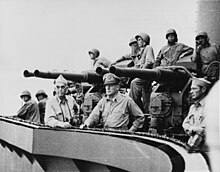Thomas C. Kinkaid
Thomas Cassin Kinkaid (born April 3, 1888 in Hanover , New Hampshire , † November 17, 1972 in Bethesda , Maryland ) was an admiral in the United States Navy . He was the commander of the Allied Naval Forces in the Southwest Pacific and the US 7th Fleet between 1943 and 1945 .
Life
Early years and World War I
Kinkaid was born into a family with a long naval tradition. His father was a rear admiral . In June 1908 he graduated from the US Naval Academy in Annapolis , Maryland . He spent his first years of service on the battleships USS Nebraska and USS Minnesota . In September 1913, he enrolled in the School of Marine Engineering in Annapolis, Maryland and took a course in artillery engineering . From 1916 to 1918 he served on the USS Pennsylvania , which operated together with the Royal Navy in the Grand Fleet after the US declaration of war on the German Reich on April 6, 1917 .
Interwar period
After the end of the war he became an artillery officer on the USS Arizona , which, among other things, provided the escort for US President Woodrow Wilson when the latter went to Paris for the peace talks . He then went to Washington , where he held various positions in the Department of the Navy and in the Bureau of Ordnance , the replenishment agency that had no longer existed since 1959 .
Between 1922 and 1924, Lieutenant Commander Kinkaid served as an assistant staff member to the commander of the U.S. Naval Delegation in Turkey . His first command then followed aboard the destroyer USS Isherwood . From 1925 to 1927 he worked at the Naval Gun Factory , located in the Washington Navy Yard , which built and tested components of ship artillery pieces until the early 1960s. By 1930 he studied at Naval War College in Newport , Rhode Island . Subsequently, Kinkaid was employed as a consultant for naval affairs in the allegiance of the then Minister of the Navy Charles Francis Adams during the Geneva Disarmament Conference from 1931 to 1932.
He was first officer on the USS Colorado between 1933 and 1934 , followed by a service in the Bureau of Navigation that lasted until mid-1937 . Then Kinkaid became captain of the cruiser USS Indianapolis . From 1938 to 1941 he was appointed naval attaché in the US embassies in Rome and Belgrade .
Second World War
On the eve of the Japanese attack on Pearl Harbor and the ensuing outbreak of the Pacific War , Kinkaid commanded various destroyer squadrons . In the spring of 1942 he was promoted to Rear Admiral and commanded cruiser divisions during the naval battles in the Coral Sea and the Battle of Midway . In the Battle of the Coral Sea , he was for his services during the evacuation of the stricken and eventually sunk the aircraft carrier USS Lexington with a medal awarded.
In the second half of 1942 he commanded the task force around the carrier USS Enterprise , during the fighting for the Solomon Islands Guadalcanal . Admiral Frank Jack Fletcher was in command .
In January 1943 he became Commander in Chief of the Naval Forces during the retaking of the Aleutian Islands of Attu and Kiska in the North Pacific.

In November of the same year he returned to the warmer regions of the Pacific and took over the 7th US Fleet in the rank of Vice Admiral . As commander of all allied naval forces in the Southwest Pacific, Kinkaid supported the landings of General MacArthur's Australian and US troops as part of Operation Cartwheel , which among other things brought about the retaking of New Guinea . Working with MacArthur helped ensure that the US 7th Fleet was also referred to as McArthur's Navy . His ships were involved in the sea and air battles in the Gulf of Leyte in the Philippines and supported the landings in the Gulf of Lingayen and Borneo .
Towards the end of the war in August 1945, Kinkaid assisted the 7th US fleet with landings in China and Korea .
post war period
After Japan surrendered on September 2, 1945, Admiral Kinkaid served as commander of the US Atlantic Fleet and reserve fleet until his retirement in May 1950. From 1951 to 1953 he returned to active service and served as a member of the National Security Training Commission . He held this office until the end of this decade. He then worked in the American Battle Monuments Commission until 1968 .
Thomas Cassin Kinkaid died on November 17, 1972 at Bethesda Naval Hospital , Maryland .
His awards include a .: the Navy Distinguished Service Medal with quadruple oak leaves and the British Order of the Bath (awarded by King George VI himself). He also received the title of Grand Officer of the Order of the Orange Nassau with Swords from Queen Wilhelmina of the Netherlands . It was in honor destroyer of the Spruance class USS Kinkaid named. He was in service from 1974 to 2004.
Web links
| personal data | |
|---|---|
| SURNAME | Kinkaid, Thomas C. |
| ALTERNATIVE NAMES | Kinkaid, Thomas Cassin (full name) |
| BRIEF DESCRIPTION | US Navy Admiral |
| DATE OF BIRTH | April 3, 1888 |
| PLACE OF BIRTH | Hanover |
| DATE OF DEATH | 17th November 1972 |
| Place of death | Bethesda |
